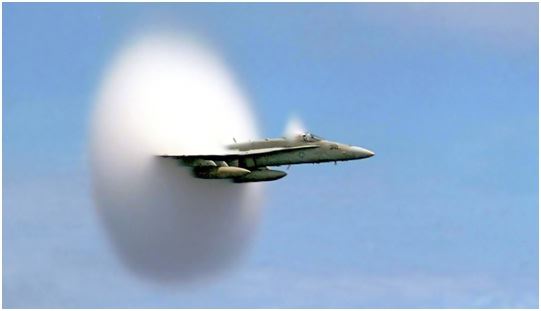What is Mach Number?
The Mach number is the ratio of flow velocity after a certain limit of the sounds speed. In simple words, it is the ratio of the speed of a body to the speed of sound in the surrounding medium.

Following is the table explaining other related concepts of fluid flow:
| Fluid Flow |
| Derivation Of Continuity Equation |
Mach Number Formula
The formula of Mach Number is:
| M = u/c |
Where,
- The Mach number is M
- Based on the limits the local flow velocity is u
- The speed of sound in that medium is c
We can say the speed of sound can be equated to Mach 1 speed. Thus, Mach 0.75 will be 75% of the speed of sound that is also called subsonic, and Mach 1.65 will be 65% faster than the speed of light, which is also called supersonic.
The Mach number due to the local speed of sound is dependent on the surrounding mediums in specific temperature and pressure. Flow can be determined as an incompressible flow with the help of the Mach number. The medium can either be a liquid or a gas. The medium can be flowing, whereas the boundary may be stable or the boundary may be travelling in a medium that is at rest. The medium and boundary both may be travelling with a certain speed, but their velocities with respect to each other are what matters. The medium may be channelled through several devices such as wind tunnels or may be immersed in the medium. The Mach number is termed as a dimensionless number because it is a ratio of two speeds.
An Austrian philosopher and physicist Ernst Mach is after whom the Mach number is named. Due to it being a dimensionless quantity and not a measurable unit, the number is put after the term Mach for instance, Mach 4 and not 4 Mach.
Mach Number Classification
Speed below the speed of sound is termed as subsonic whereas speed above the speed of sound is termed as supersonic, although scientists practising aerodynamics most of the time use these terms to describe a particular range of Mach values.
The various regimes of Mach values are:
| Regime | Subsonic | Transonic | Sonic | Supersonic | Hypersonic | Hypervelocity |
| Mach | <0.8 | 0.8–1.3 | 1.0 | 1.3–5.0 | 5.0–10.0 | >10.0 |
Subsonic:
Commercial aircraft with aerodynamic features such as the rounded nose and leading edges. The Mach is below 0.8.
Transonic:
Aircraft that are built with swept wings. The Mach value is between 0.8-2.1.
Supersonic:
The aircraft created to go supersonic have a definite design, it has the complete movement of the canards, thin aerofoil sections, and sharp edges. The Mach levels are between 1.2 and 5.0.
Hypersonic:
These planes have several distinctive features such as nickel-titanium skin that is cooled and small wings. The Mach values are between 5.0 and 10.0. The U.S. plane X-15 created the world record of flying at Mach 6.72.
High-Hypersonic:
The Mach levels are between 10.0 -25.0. When flying at such huge speeds thermal controls becomes an integral portion of the design. The hotness of the surface must be considered beforehand.
Re-entry speeds:
The Mach speed is above 25.0. This does not require wings and a blunt design.
Classification of Mach Regimes
| Regime | |||||
| (Mach) | (knots) | (mph) | (km/h) | (m/s) | |
| Re-entry speeds | >25.0 | >16,537 | >19,031 | >30,626 | >8,508 |
| High-hypersonic | 10.0–25.0 | 6,615–16,537 | 7,680–19,031 | 12,251–30,626 | 3,403–8,508 |
| Hypersonic | 5.0–10.0 | 3,308–6,615 | 3,806–7,680 | 6,126–12,251 | 1,702–3,403 |
| Supersonic | 1.3–5.0 | 794-3,308 | 915-3,806 | 1,470–6,126 | 410–1,702 |
| Transonic | 0.8–1.3 | 530–794 | 609–914 | 980–1,470 | 273–409 |
| Subsonic | <0.8 | <530 | <609 | <980 | <273 |
FAQs on Mach Number
Q1. What is Mach number significant for?
Ans: The flow in the air is having higher speeds than the sound and that is the significance of Mach number.
Q2. Name the flows for which Bernoulli’s equation is applicable.
Ans: Following is the list of flows for which Bernoulli’s equation:
- Rotational flow
- Turbulent flow
- Unsteady flow
Q3. What is the relative density of mercury?
Ans: The relative density of mercury is 13.6.
Q4. What is relative density?
Ans: Relative density is defined as the ratio of a substance to the ratio of water for liquid and solid and air for gas.
Q5. What is the unit of relative density?
Ans: Relative density is a dimensionless quantity. Therefore, it doesn’t have a unit.
Q6. What is Newtonian fluid?
Ans: Newtonian fluid is defined as the fluid that has viscous stress proportional to the local strain.
Q7. When is a flow called supersonic?
Ans: When the Mach number is between 1 and 5, the flow is known as supersonic.
Q8. Express 1 bar pressure in kPa.
Ans: 1bar=100 kPa.
Q9. What is the Reynolds number?
Ans: Reynolds number is defined as the ratio of inertia force to viscous force.
Q10. What is Reynolds number for laminar flow?
Ans: Reynolds number for laminar flow is less than 2300.
Stay tuned with BYJU’S for more such interesting articles. Also, register to “BYJU’S – The Learning App” for loads of interactive, engaging Physics-related videos and an unlimited academic assist.




Comments